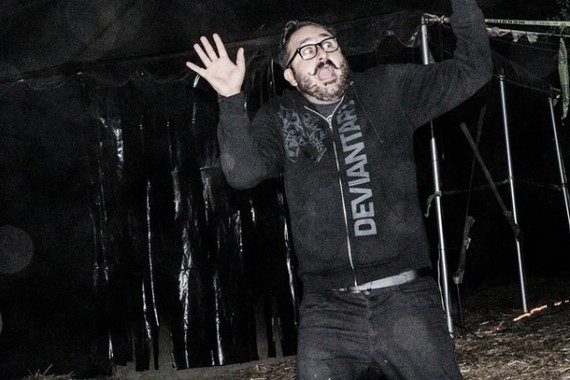Over the weekend I visited a haunted house. I wouldn't say it was your typical haunted house, it was rather an LA affair with sponsorships from Mini Cooper and vegan treats as well as world-class makeup and effects by some Hollywood effects types. The whole experience was great fun. See that? I said it was "FUN." In fact, all signs point to everyone having a great time, giggling and laughing between screams and squeals, which got me to thinking:
WHY DO WE LAUGH DURING HORROR FILMS AND HAUNTED HOUSES?
I'm not sure how much terror I've actually experienced in my life. Some close calls on the freeway, a couple of "oh god" moments on a plane with serious turbulence, hospital stays and waiting for diagnoses, explaining credit card charges to my mom when I was in college... you know, the classic terror-filled scenarios of someone who considers using AirBNB an adventure. In those few moments of what I identify as "true fear," not once did I laugh. Nowhere was laughter anywhere near me; mirth did not peek around the corner; humor was not in attendance; glee was amiss; jocundity took a vacation; the land of happiness was terra incognita. So if those moments were so devoid of laughter, how is it that I recognize the emotions I go through at a haunted house or at a horror film as fear, but I also end up giggling and enjoying myself tremendously?
I lead a charmed life, no doubt. Whenever I have a question like this I often find myself in a position to ask people who would have insight, and this time around I happened on none other than Mr. Wes Craven.
Yes, the Wes Craven. The man behind Nightmare On Elm Street, The Hills have Eyes, and Paris Je T'aime. He was doing a Q&A at the Cinefamily after a screening of People Under The Stairs in Los Angeles and I decided to press him on the use of levity in his films.
"Horror and comedy are like brother and sister," is the only line I dare quote directly, since I wasn't really taking notes when he answered my question.
Apologies to the Master of Horror if I misrepresent or misconstrue his statements but basically, he said that both horror and comedy are all about building pressure and the only deviation is the release. You can either horrify people or make them laugh after you've built up the pressure. This explains the frequent use of both comedic devices in horror and the horrifying nature of bad comedy, and in retrospect I think I cringe at terrible comedy as much as I do at a horror film. That explains a little bit about the nature of comedy and horror in films, but what about the laughter I encountered in haunted houses?
Again I find myself turning to Peter McGraw's Benign Violation theory for answers. According to Pete McGraw and his research, in order for laughter and humor to happen, there must be a violation in place that proves to be benign. So, for you to actually laugh, you must know that there is no real danger to you or others. That would make haunted houses a prime location for real laughs rather than actual fear.
It works something like this:
1. You and your friends get pumped to go into a haunted house. You hear screams coming from inside and you begin to giggle nervously.
2. You decide who is going to be the first person in. Usually a male who is a good sport and jokes a lot.
3. As you walk through, the pressure builds through darkness, strobe lights, fog and other disorienting tricks.
4. Pressure reaches a boiling point. You know something is around the corner but you are simultaneously aware that that thing is not allowed to actually kill or harm you.
5. The ghoul/teen in a latex mask jumps out at you, you scream in shock, and you realize that the threat is not real, so you laugh.
6. Repeat steps 3, 4, and 5 about 2 dozen times.
There are currently attempts by horror attraction sorts to take the "safety" aspect away from their attractions by having people sign waivers that allow them to be touched, masked, dragged, etc. While that may sound horrific, and certainly takes the safe feelings down a notch, the real danger is questionable since I'm fairly certain that death or dismemberment is not the end game, and everyone involved knows it. Despite claims to truly terrorize or even "ruin you," we should accept that both horror attractions and horror films have more in common with a comedy open mic, in both cringes and laughs than with the true terror and fear.
I can't wait to hear your anecdotal evidence saying otherwise in the comments

